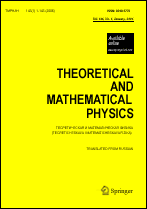|
This article is cited in 2 scientific papers (total in 2 papers)
Quantum mechanics and the hydrogen atom in a generalized Wigner–Seitz cell
K. A. Sveshnikovab
a Bogoliubov Institute for Theoretical Problems of
Microphysics, Lomonosov Moscow State University, Moscow, Russia
b Physics Department, Lomonosov Moscow State University, Moscow, Russia
Abstract:
We investigate the energy spectrum of a nonrelativistic quantum particle and a hydrogen-like atom placed in a vacuum cavity with general boundary conditions ensuring confinement. When these conditions, as in the Wigner–Seitz model, admit a large amplitude of the wave function on the boundary of the cavity, a nonperturbative rearrangement of lower energy levels of the spectrum occurs, which is essentially different from the case of the confinement by a potential barrier. A nontrivial role in this spectrum rearrangement is played by the von Neumann–Wigner effect of repulsion of nearby levels. For such a confined state of a hydrogen-like atom in a spherical cavity of radius $R$ with the boundary formed by a potential layer of depth $d$, we show that the lowest energy level of the atom has a pronounced minimum at physically meaningful layer parameters and that the binding energy can be much greater than $E_{1s}$, the energy of the 1s level of a free-standing atom, and that the regime where the atom binding is much greater than $E_{1s}$ becomes possible for a cavity with $R\sim10$–$100$ nm.
Keywords:
confinement of quantum systems, energy spectrum rearrangement, hydrogen atom, Wigner–Seitz model.
Received: 01.02.2013
Revised: 14.03.2013
Citation:
K. A. Sveshnikov, “Quantum mechanics and the hydrogen atom in a generalized Wigner–Seitz cell”, TMF, 176:2 (2013), 254–280; Theoret. and Math. Phys., 176:2 (2013), 1044–1066
Linking options:
https://www.mathnet.ru/eng/tmf8508https://doi.org/10.4213/tmf8508 https://www.mathnet.ru/eng/tmf/v176/i2/p254
|


| Statistics & downloads: |
| Abstract page: | 642 | | Full-text PDF : | 258 | | References: | 75 | | First page: | 31 |
|




 Contact us:
Contact us: Terms of Use
Terms of Use
 Registration to the website
Registration to the website Logotypes
Logotypes








 Citation in format
Citation in format 
